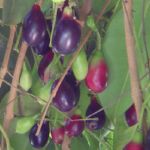| Common Name: |
Java Plum |
| Other Names: |
Jambolan, Jambul |
| Botanical Name: |
Syzygium cumini |
| Genus: |
Syzygium |
| Family: |
Myrtaceae |
| Native Location: |
India, Sri Lanka, and Java; widely cultivated in the tropics. |
| Cultivation: |
Well-drained, fertile soil in sun. |
| Propagation: |
By seed sown when ripe or in spring at 27°C (81°F); by greenwood cuttings in early summer; by semi-ripe cuttings in summer. |
| Harvest: |
Unopened flower buds (S. aromaticum) are picked as they develop and sun-dried for use in infusions and powders, and for oil extraction. Bark (S. cumini) is removed from prunings as required and dried for decoctions. Fruits (S. cumini) are collected when ripe and dried whole, or seeds are removed and dried separately for decoctions and tinctures. |
| Hardiness: |
Min. 15-18°C (59-64°F) |
| Height: |
20m (60ft) |
| Width: |
10m (30ft) |
| Parts Used: |
Bark, fruits, seeds |
| Properties: |
A bitter, strongly astringent, aromatic herb that has diuretic effects. It improves digestion and significantly lowers blood sugar levels. |
| Medicinal Uses: |
Internally for indigestion, flatulence, colic, diabetes, (fruits, seeds), diarrhea, dysentery (bark, seeds). Externally for gum disease and ulcers (bark). |
| Culinary Uses: |
Astringent fruits are used to make jam, jelly, preserves, and vinegar. Powdered bark is an ingredient of basi, a wine based on sugar cane juice (Phillipines). |
| Bibliography: |
Aromatherapy Blends and recipes by Franzesca Watson Copyright © 1995 Thorsons, Harper Parker Publishing Inc. Pp 92-93
Magical Aromatherapy by Scott Cunningham Copyright © 1988 Llewellyn Publications, Inc. pp76-77
The Encyclopedia of Herbs by Deni Bown Copyright © 1995, 2001 Dorling Kindersley Limited pg. 378 |

